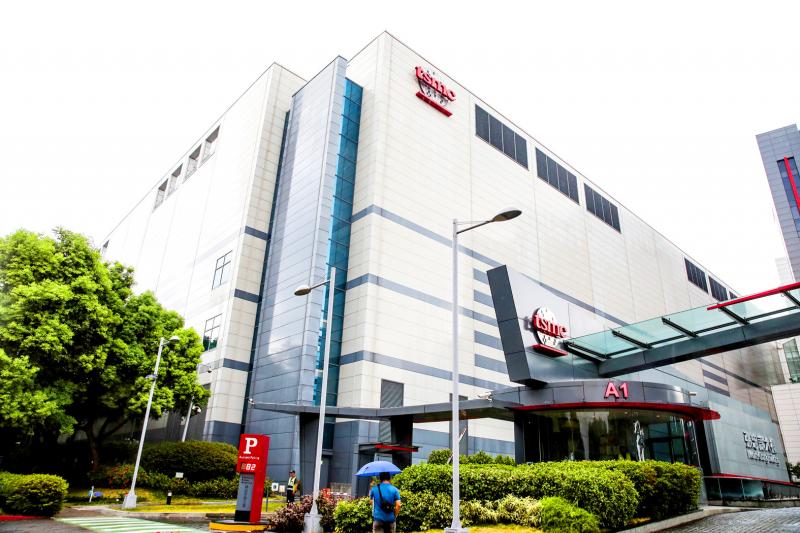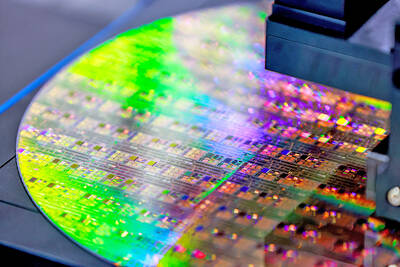The TAIEX early yesterday hit an all-time intraday high on the back of soaring Taiwan Semiconductor Manufacturing Co (TSMC, 台積電) shares, before tumbling back to the previous day’s close as the contract chipmaker could not single-handedly prop up the index.
The TAIEX rose more than 400 points in the first 20 minutes of trading to hit a record 13,031.7 points, but later pared its gains to close down 0.01 percent at 12,586.73.
Turnover was NT$343.252 billion (US$11.63 billion), the highest in the Taiwan Stock Exchange’s history.

Photo: Bloomberg / I-Hwa Cheng
TSMC continued to dictate the market’s direction, as its early surge by the daily maximum 10 percent to NT$466.5 accounted for more than 350 points of the TAIEX’s early gains.
The company also vaulted into the world’s top 10 firms in terms of market capitalization, ahead of Johnson & Johnson and Visa Inc.
TSMC shares later retreated, closing up 2.47 percent at NT$435, which still represented a 39 percent gain this month.
Its gains kept the TAIEX from falling steeply, after contributing 327 points to the benchmark index a day earlier, when the overall index rose 284.26 points.
“TSMC’s one-stock show has been rarely seen in decades,” Shin Kong Investment Trust Co (新光投信) chairman Quincy Liu (劉坤錫) said.
“The broader market has been held together by TSMC the past two days. Yesterday, MediaTek Inc (聯發科) helped out, and today support was seen from LED, Apple Inc-concept and bicycle stocks, which is a healthier trend than yesterday,” Liu said.
The TAIEX rose 2.31 percent on Monday, despite 763 stocks falling and 150 stocks rising.
“With every NT$1 increase in TSMC equaling an 8.5-point increase in the TAIEX, TSMC has accounted for about 90 percent of the index’s gains in the past two days,” Liu said.
Among other gainers in the Apple supply chain, iPhone assembler Hon Hai Precision Industry Co (鴻海精密) rose 0.5 percent to NT$78.4 and smartphone camera lens supplier Largan Precision Co (大立光) gained 2.49 percent to NT$3,910.
Several other electronics stocks could not stay in positive territory.
MediaTek ended down 6.59 percent at NT$680 after a 4 percent rise earlier, Marketech International Corp (帆宣) plummeted 7.57 percent to NT$116 to erase an earlier gain of 9 percent and Yageo Corp (國巨) fell 5.42 percent to NT$384, off a high of NT$420.
Liu said that TSMC’s success is due to its favorable position in a world where China is “de-Americanizing” and other countries are distancing themselves from China.
“TSMC’s ability to make high-end chips for artificial intelligence, high-performance computing and smart manufacturing applications in the 5G era gives it an invaluable role, allowing it to benefit from both the ‘de-Americanization’ and ‘de-Sinicization’ trends,” Liu said.
Tsai Ming-han (蔡明翰), a manager at Cathay Futures Corp (國泰期貨), said the TAIEX’s rally has come to an end for the time being.
He said he expects the market to remain turbulent in the short term, but remains bullish regarding medium and long-term prospects.

Taiwan’s foreign exchange reserves hit a record high at the end of last month, surpassing the US$600 billion mark for the first time, the central bank said yesterday. Last month, the country’s foreign exchange reserves rose US$5.51 billion from a month earlier to reach US$602.94 billion due to an increase in returns from the central bank’s portfolio management, the movement of other foreign currencies in the portfolio against the US dollar and the bank’s efforts to smooth the volatility of the New Taiwan dollar. Department of Foreign Exchange Director-General Eugene Tsai (蔡炯民)said a rate cut cycle launched by the US Federal Reserve

The US government on Wednesday sanctioned more than two dozen companies in China, Turkey and the United Arab Emirates, including offshoots of a US chip firm, accusing the businesses of providing illicit support to Iran’s military or proxies. The US Department of Commerce included two subsidiaries of US-based chip distributor Arrow Electronics Inc (艾睿電子) on its so-called entity list published on the federal register for facilitating purchases by Iran’s proxies of US tech. Arrow spokesman John Hourigan said that the subsidiaries have been operating in full compliance with US export control regulations and his company is discussing with the US Bureau of

Businesses across the global semiconductor supply chain are bracing themselves for disruptions from an escalating trade war, after China imposed curbs on rare earth mineral exports and the US responded with additional tariffs and restrictions on software sales to the Asian nation. China’s restrictions, the most targeted move yet to limit supplies of rare earth materials, represent the first major attempt by Beijing to exercise long-arm jurisdiction over foreign companies to target the semiconductor industry, threatening to stall the chips powering the artificial intelligence (AI) boom. They prompted US President Donald Trump on Friday to announce that he would impose an additional

Pegatron Corp (和碩), a key assembler of Apple Inc’s iPhones, on Thursday reported a 12.3 percent year-on-year decline in revenue for last quarter to NT$257.86 billion (US$8.44 billion), but it expects revenue to improve in the second half on traditional holiday demand. The fourth quarter is usually the peak season for its communications products, a company official said on condition of anonymity. As Apple released its new iPhone 17 series early last month, sales in the communications segment rose sequentially last month, the official said. Shipments to Apple have been stable and in line with earlier expectations, they said. Pegatron shipped 2.4 million notebook